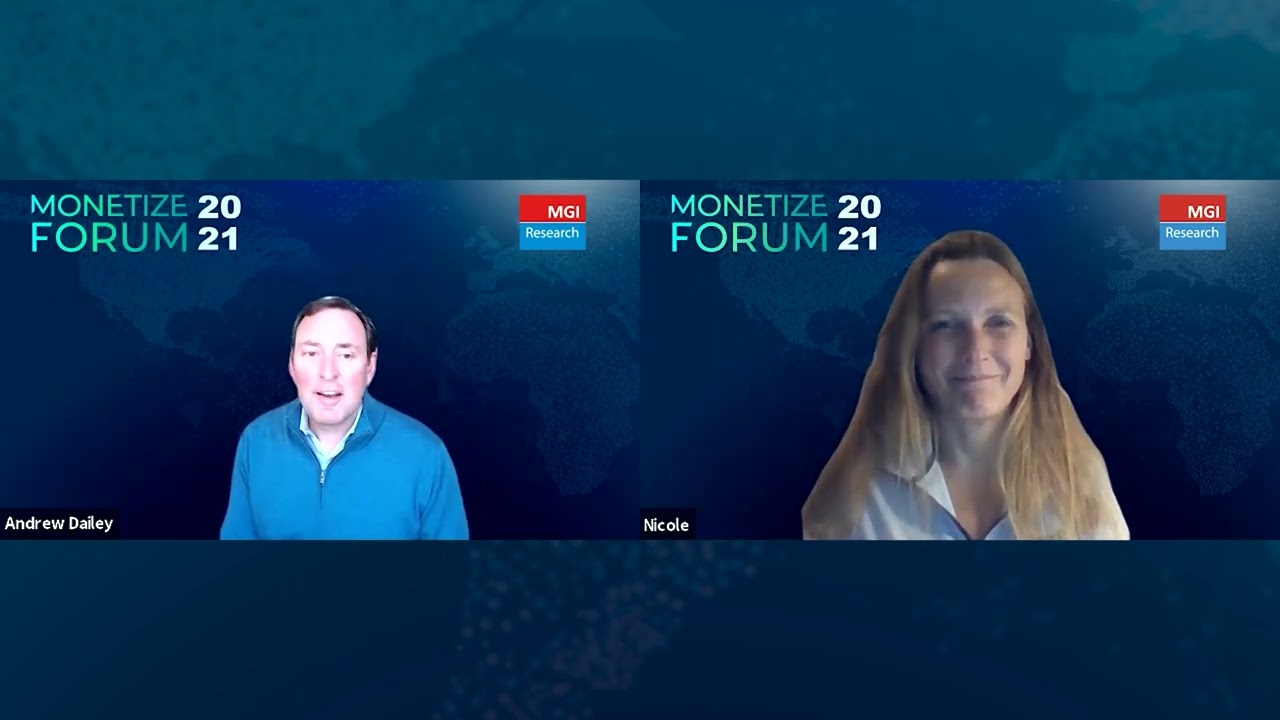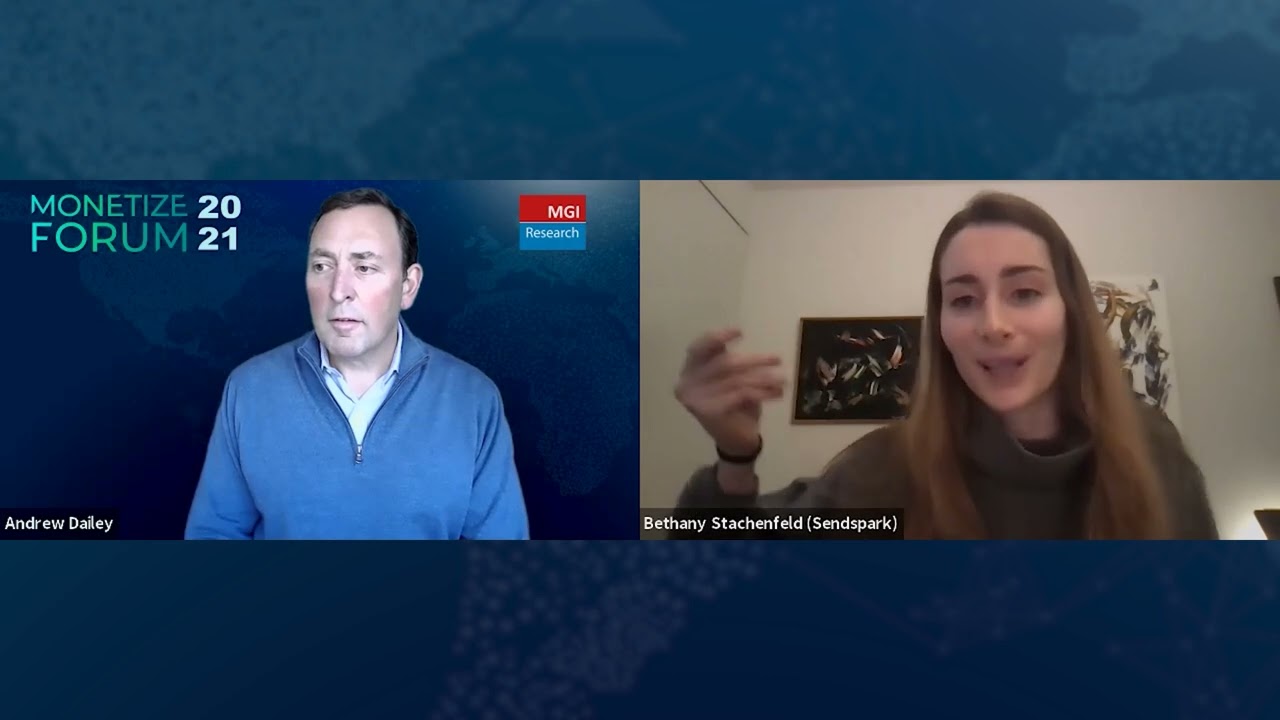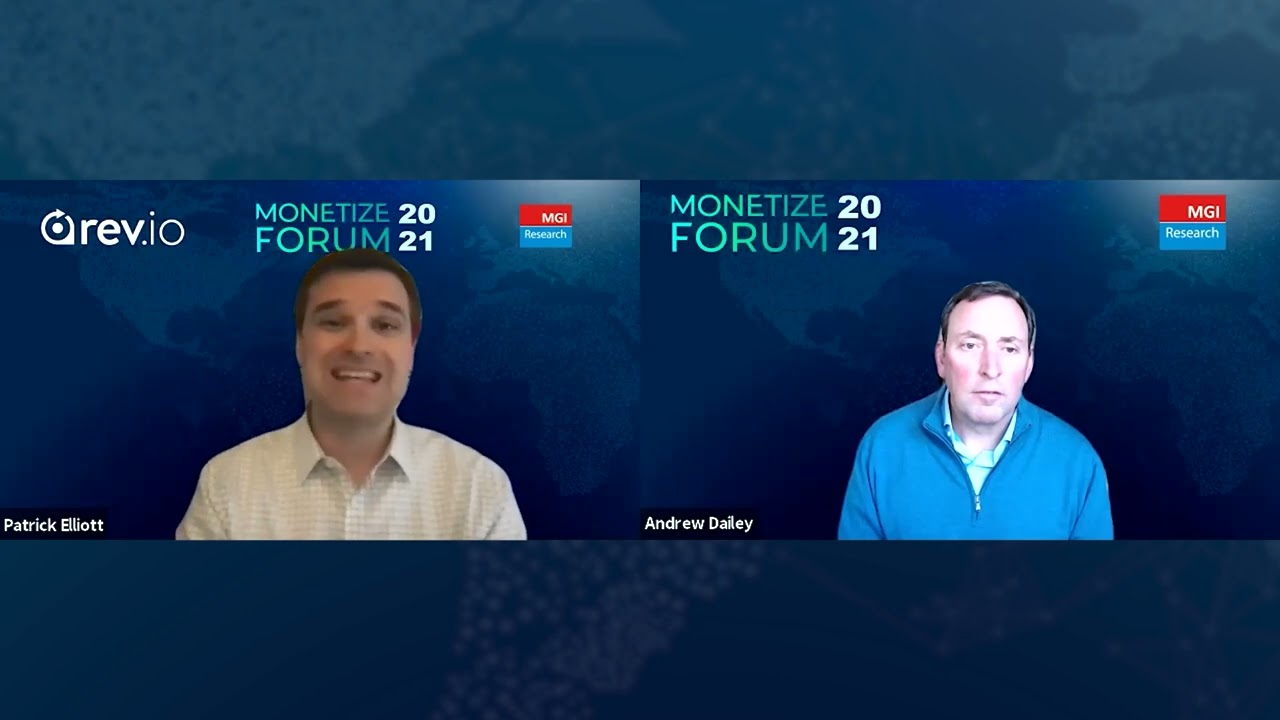While the back office of an organization is unanimously recognized as a business necessity, it often doesn’t receive the same enthusiasm and interest that the flashier sales front naturally inspires. As a result, many companies don’t realize the full value a strong billing system can bring to their overall operations. Atlantech Online is a prime example of how strategically positioning billing as a foundation for other functions can both drive revolutionary change in existing practices and prepare a business to handle growing complexity. We invited the company’s President, Ed Fineran, to speak with MGI Research analyst Andrew Dailey at the 2021 Monetize Forum to tell us more about his experience with the Rev.io billing system. Ed also offers his perspective on what the post-pandemic office might look like.
Key Issues
How can billing best support for other business operations?
Why is billing capability such a key differentiator between providers?
What might the post-pandemic workplace look like?
Guest Profile
Ed is the President of Atlantech Online, a public utility in Maryland, Virginia and the District of Columbia that provides telephone, Internet and data center services to business and governmental organizations. Ed has over 25 years’ experience working in the telecommunications industry and both Bachelor of Arts and Master of Business Administration degrees from the University of Maryland, College Park.
Andrew Dailey
Hi, everyone. This is Andrew Dailey of MGI Research, and welcome to our session, “Think Bigger, Move Faster: How Monetization + Analytics Catalyze Atlantech.” Our next conversation is with an executive from an industry undergoing a significant amount of fundamental change. It’s shifting from a hardware and physical goods and services orientation to much more emphasis on software and services. It’s also a business that’s an indicator of what the potential post-COVID workplace could look like. As it relates to billing and monetization, our guest believes that the back office can really be a core enabler of improving customer satisfaction and driving financial performance. So, with that as a backdrop and to put all of this into higher resolution, I’m delighted to be joined by Ed Fineran, the President of Atlantech Online. Welcome, Ed.
Ed Fineran
Thank you, Andrew. It’s good to be here.
Andrew Dailey
Let’s first start with your business, Atlantech. Give us a sense of what you guys do and where you are today.
Ed Fineran
Sure. Atlantech Online is a telephone and internet service provider to business and government. We provide telephone service throughout the United States, and we provide fiber and data center services, primarily in the Washington, D.C. region. We have all different types of telephone service—anything a corporation or a government would need, and on the fiber side, we have fiber into over 20,000 buildings in the Washington, D.C. region, including Northern Virginia and Maryland. We have pre-lit a little over 200 of those buildings with fiber, so it’s very easy for tenants to get instant access to fiber. We also have two data centers just north of Washington, D.C. where customers place their equipment. We’ve been doing this now for over 25 years.
Andrew Dailey
You’ve been pushing the business to, as you say, “think bigger and move faster.” What does that mean, specifically as it relates to your billing and monetization?
Ed Fineran
Billing really supports our entire business drive right from the quoting process. We use Salesforce to quote all of our customers, and once a customer signs off, the data flows directly from Salesforce into our billing system. We use a billing system called Rev.io, so it immediately flows into Rev.io, and then that kicks off processes to deliver services to the customers. Once the services are installed, billing takes over, and we’re able to support our customers through it. It’s tremendous flow to make sure that the business is going strong.
Andrew Dailey
Billing is often considered kind of a back-office, necessary evil in business—it’s not particularly sexy. You have a really different view in that you see it as the core backbone of what you do and recognize the data coming from billing as serving a lot of different needs. Did you always think this way? How did you come to that point of view?
Ed Fineran
This was really crystallized when we won one of the largest school systems in the country about 10 years ago. They had the incumbent telephone service provider in the region and over 300 sites, and they would get a telephone bill each month about the size of a yellow pages—they had no way to analyze that. They brought us in not only for better service and less expense, but also because the billing was so clear, and we could provide them customized forms. In Rev.io, this is so easy to do with their APIs that we met a lot of their needs, and the billing person is now thrilled because they are able to get it. In the telephone industry, billing is huge for customers in being able to understand their bills. So, for a long time, I’ve seen this as a way to win business and keep customers satisfied.
Andrew Dailey
Yes, absolutely, and we see that not just in telco but in every industry now.
Ed Fineran
I’m sure.
Andrew Dailey
Like many of your peers and many businesses last year, you were intensely focused on getting even tighter control over receivables and payables. What did you do specifically to improve in those areas?
Ed Fineran
Heading into the pandemic, considering the whole concept of cash flow and accounts receivable, it was a nervous time. We have analytics tools on the tie-in to Rev.io using Microsoft Power BI, and we’re very easily able to see breakdown of our accounts receivable so that our customer service teams can follow up with customers and have insight into what their actions are with regard to that. A lot of times, it was just a matter of communication with customers. People often change their email addresses, phone numbers, jobs, and things like that, and we’re able to stay on top of it. So, the tools and being able to connect with customers is pretty key for that.
On the payable side, historically (for about 24 and a half years), we’ve been using checks to pay everything. It’s just a clean way to do it; you pay a check, and it’s done. For security and also to minimize paper-touching during the pandemic, we’ve switched now to mostly ACH. That has sped up payments and made the whole thing move a lot easier.
Andrew Dailey
Yes, I want to go back to one of the things you touched on just a couple minutes ago which is how you’ve kind of streamlined the whole order flow from your CRM system all the way through. Can you describe what the order flow looks like from CRM into billing and then even provisioning?
Ed Fineran
Sure. So, in Salesforce (a lot of companies use Salesforce or some other CRM), the sales team uses it to pursue customers and opportunities. They identify opportunities, and usually, an opportunity has a quote associated with it. Inside the quote, we’re able to select products that are in our billing system. So that’s where it really ties it together—the specific products. The product catalog in Salesforce matches the product catalog inside Rev.io. So, once the customer signs off (we use an electronic signing tool, so they sign electronically), the salesperson hits go on the order, and that whole product set that’s in the quote flows directly into Rev.io, our billing system, which kicks off the ordering process. Then we have an installation team that has tasks associated with each of those items, separate items so there could be people working on various installation portions of the order. Then, as they get completed, they’re converted into billing items in the system, so they get billed out the following month.
Andrew Dailey
Let’s kind of drill into that even a little more because I know you’re in there putting very high-capacity fiber and networking into office parks where you may be one of multiple providers or where you’re replacing many others. Describe the connection between both the order management and the provisioning and de-provisioning of services and how that translates into the bottom line.
Ed Fineran
I have a good example for you. A little less than a year ago, one of the largest consulting firms in the world was moving into a brand-new office building in which we were the only service provider of fiber. However, they didn’t choose us in the beginning because they didn’t know us. Well, the other service provider (that other fiber carrier they went with) couldn’t deliver, so the day before they were moving in, we called their CIO said, “How’s your move going?” He wanted to place a gigabit per second order immediately, so we sent out the quote through Salesforce, and he signed it instantly. I don’t even think he read the agreement.
That then flowed right into our system and kicked off an order for our field service team to go to the property on a Saturday to get it installed, so when they moved in on Monday, the CEO of this huge global company had internet access. So, having these systems in place really sped the order through our various departments. They were able to assign IP addresses and everything that they needed to get it done, there were automatic notifications to the customer of the details, and it got installed. So, having these systems in place ahead of time definitely speeds the cash flow. We’re able to immediately bill the customer for a service they ordered on Friday. They’re using it Monday, so we’re able to bill right away. So, it’s really end-to-end, from the quote end all the way through to the cash side.
Andrew Dailey
And that’s all completely touchless. Essentially, it sounds like you’ve pretty much eliminated all paper.
Ed Fineran
There’s no paper on our flow. We used to have reams of paper and had to pass paper back and forth between departments. Now, we’ve completely eliminated paper. Instead, everything is task-generated from the order, and each of the assigned employees for the various tasks gets them done. Sometimes, these tasks go between departments, but it’s all orchestrated through the Rev.io billing platform.
Andrew Dailey
As you look out into 2021 and even beyond, what’s on your roadmap from a billing and broader kind of monetization point of view? What are the next things that you want to get done?
Ed Fineran
One of the things we want to get done is to make sure that our billing product items match up with today’s environment—having the product catalog support our teams better so that the right information is in the right place because we find it speeds along customer questions when all of the data is in the right place. I think some of our product catalog items could be better, and there’s a project underway right now to get that done. Additionally, we’re going through all of our analytics tools to make sure that we’re able to quickly pull out that same sort of data. So, everything’s about speed: speed to support customers, speed to deliver services. Having the right product catalog is key.
Andrew Dailey
Your customers can have complex environments. For example, you described the school district—they have many locations, and each location has a lot of complexity. How do you maintain the view of “as-is” or what’s installed so that you can understand what’s in place correctly?
Ed Fineran
There’s a complex answer for that because it’s not just the billing system. The billing system is what I would call the truth holder of the key data, but we have lots of systems that we use, including fiber mapping so that we know where every strand of fiber is assigned and located and what circuits are associated with them. We also have monitoring tools—tools that check our equipment throughout the footprint every five minutes to make sure they’re alive. So, we’re very proactive, and there’s a tie between what’s in the billing system and the monitoring tools to make sure those items that are in the billing system are being monitored. Then, we have other data flow and monitoring tools for our phone system. It’s all tied together, but we have many different angles depending on the products and alerting tools, just in case there’s any problems anywhere in the network.
Andrew Dailey
Got it. As we enter 2021 here, one of the great questions facing every CFO and CEO is, what’s the composition of the workforce going to look like? How much is going to be back into an office environment, and how much is going to be work from home? You guys have kind of a unique insight into that as you both see the networking into buildings and are also a provider of a lot of the collaboration tools (Microsoft Teams and others) that people are taking advantage of in working from anywhere. How do you think it’s going to shake out, not only this year but as you look forward?
Ed Fineran
I think there are going to be multiple phases to this. I think in the initial phase, we’re going to see teams, specific departments, coming into the office two or three times a week and rotating that. There are going to be combinations of certain employees who are just more comfortable being at home. There are a lot of people scared out there today, and at this point, some of them are saying, “I am not coming back into the office.” These are valuable employees, and you want to keep them hired, so companies are going to have to be flexible. At the same time, a lot of our customers are focused on having their employees back in the office from a management perspective, and they’re redesigning their office spaces.
I know that we’re doing that right now. We’re building neighborhoods in our office building for our various departments so that, when they are in the office, everybody knows where everybody is going to be because the employees are going to be in neighborhoods—at the same time, those neighborhoods may shift depending on which teams are in the office. So, there’s a lot of hotel aspect to the office space I see in the future. However, I think this is only going to last for the next two to three years. In three or four years, after the pandemic ends and assuming everything goes smoothly, I think we’re going to be heading back to more of what we’re familiar with pre-pandemic, office-wise. We don’t see larger customers giving up office space. In fact, in some of our newly fiber-lit buildings, there are some huge office space deals happening today. So, there’s no doubt that the office space is going to continue to be very important.
Andrew Dailey
Great. That was Ed Fineran, President of Atlantech Online. Ed, I’d like to thank you very much for your time here. You’ll be around for the networking later on, and your details are available here, so hopefully, people will reach out. You guys are expanding nationally, so there’s also an opportunity.
Ed Fineran
Yes, absolutely.
Andrew Dailey
So, with that, thanks everyone for joining us, and I’ll give you back your time for the Monetize Forum. Thank you.
Ed Fineran
Thank you, Andrew.





